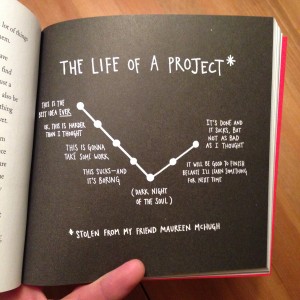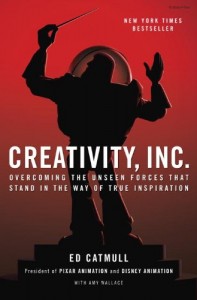
Caminante, son tus huellas el camino, y nada más; caminante, no hay camino, se hace camino al andar. Al andar se hace camino, y al volver la vista atrás se ve la senda que nunca se ha de volver a pisar. Caminante, no hay camino, sino estelas en la mar.
Wanderer, your footsteps are the road, and nothing else; wanderer, there is no road, the road is made by walking. Walking makes the road, and on glancing behind one sees the path that he will never trod again. Wanderer, there is no road— Just foam in the sea.
– Antonio Machado
Every creative endeavor is a journey, and a perilous one. Whether you’re raising a family, launching a website, making a film or writing a book, the path to realizing your creation is a roller coaster of excitement, fear, sweat and tears. Through all these highs and lows, some people persistent and realize their dream.
Into the Unknown In Ed Catmull’s
Creativity Inc, the founder of Pixar describes the journey to creating something new as a stepping into the unknown. In contrast to Michelangelo’s “every block of stone has a statue inside it and it is the task of the sculptor to discover it”, Catmull believes that the creative process involves bringing a new thing into existence, rather than discovering what’s already there.  By definition, creating something new means you’re traveling to places no one has been before. It’s like stepping forward in darkness. A journey into the unknown is filled with uncertainty. How do you subdue the voices of fear and maintain the courage to move forward into the unknown? Catmull points to the importance of mental models to motivate creators. Mental models are metaphors that help maintain perspective while in the midst of the creative journey.
By definition, creating something new means you’re traveling to places no one has been before. It’s like stepping forward in darkness. A journey into the unknown is filled with uncertainty. How do you subdue the voices of fear and maintain the courage to move forward into the unknown? Catmull points to the importance of mental models to motivate creators. Mental models are metaphors that help maintain perspective while in the midst of the creative journey.
Mental Models for Creativity
Here are some of the mental models used by directors in the Pixar team, some of which I’ve been able to relate to and found helpful in my creative process:
- Andrew Stanton (director of A Bug’s Life, Finding Nemo, WALL-E), likes to think of his role as director as being the caption of a ship at sea. Even though he may not know which direction to sail to find land, as the captain he must pick a direction and say, “Let’s sail that way”.Once the ship is moving, you can change course as you gain more information and insight. The important thing is to start moving.
“People want decisiveness, but they also want honesty about when you’ve effed up. It’s a huge lesson: Include people in your problems, not just your solutions.”
- Peter Doctor (director of Monsters Inc. and Up) compares the creative process to walking through a long, dark tunnel. As you move forward in the dark, even if you are forced to feel your way through for lack of light, there will eventually be light at the end of the tunnel.
“There’s this scary part in the middle where it’s just dark. There’s no light from where you came in and there’s no light at the other end; and then a little more light and then, suddenly, you’re out in the bright sun.”
- Brad Bird (director of The Incredibles and Ratatouille) had a recurring nightmare that he was racing down a hill in a car. The only problem was, he was in the back of the car, completely unable to steer or slow the out of control vehicle. He found the model of downhill skiing helpful in overcoming the feeling of lack of control in directing a film. Instead of fearing and tensing up at the speed of racing down a hill, Bird learned that you need to embrace the speed and lean into the turns.
“It’s going to be scary when I make the turns really fast, but I’m going to push that mountain away and enjoy it.”
Creating the Future
“When you grow up you tend to get told that the world is the way it is and you’re life is just to live your life inside the world. Try not to bash into the walls too much. Try to have a nice family life, have fun, save a little money. That’s a very limited life. Life can be much broader once you discover one simple fact: Everything around you that you call life was made up by people that were no smarter than you. And you can change it, you can influence it… Once you learn that, you’ll never be the same again.”
– Steve Jobs
You and I have an incredible opportunity. We can choose not to sit back and watch the inevitable unfold. We can decide to do more than criticize and complain, resigning ourselves to cynicism. We have the opportunity to shape the future, to make a dent, to be part of something bigger than ourselves.
The creative process isn’t easy, but we all know that it’s worth it.
Let’s create.